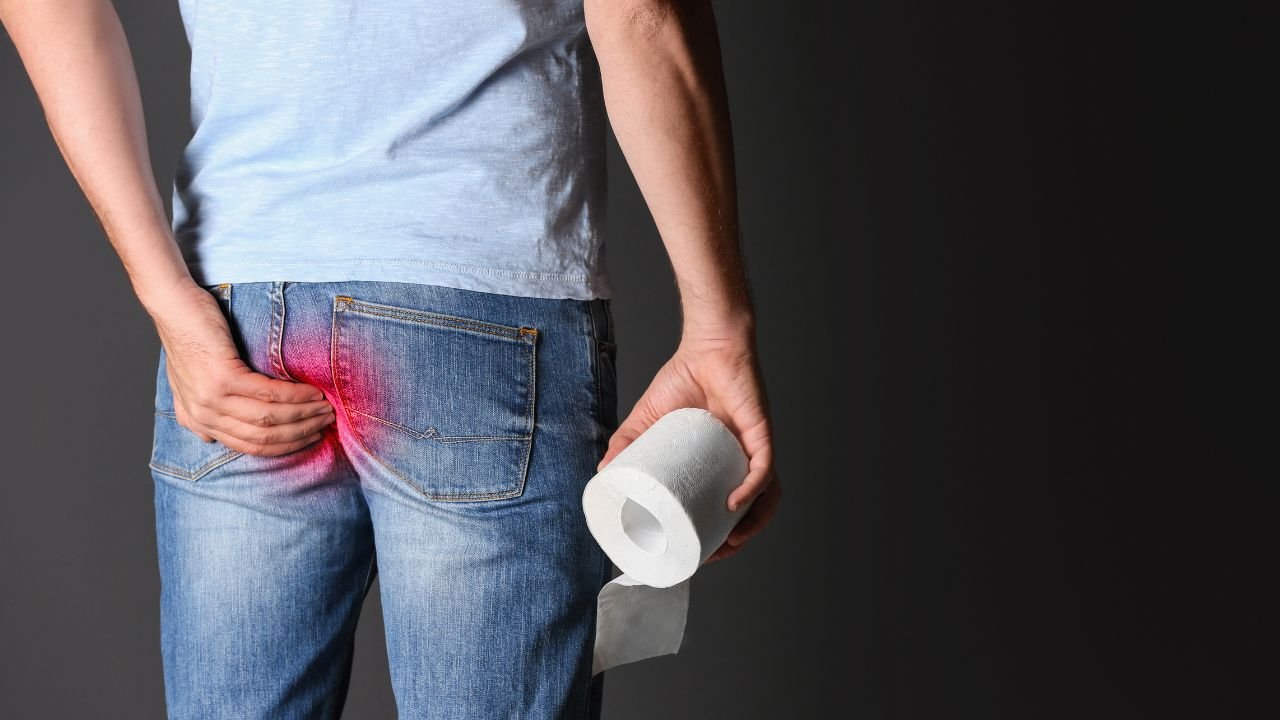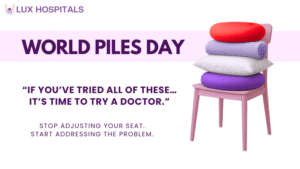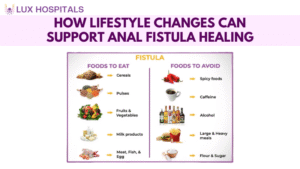External Hemorrhoid Treatment: Easy Solutions

External hemorrhoid treatment offers clear advice on easing the pain of swollen veins around the anus, also called piles. This blog covers the causes, symptoms, and various treatments for external hemorrhoids, from simple home remedies to more serious medical procedures. Whether you need tips for lifestyle changes or are considering surgery, you’ll find useful information to help you feel better and improve your daily life.
What are external hemorrhoids?
External hemorrhoids, also known as external piles, are swollen veins located under the skin around the anus, caused by too much pressure in the lower rectum.

Causes of external hemorrhoids
External hemorrhoids are a painful condition that can be caused by various lifestyle and health factors. Some common causes of external hemorrhoids include:
- Straining during bowel movements
- Sitting for a long time, especially on the toilet
- Constipation or diarrhea that lasts a while
- Lifting heavy items
- Being pregnant or giving birth
- being very overweight
- Eating a diet low in fiber
By identifying and addressing these causes, people can effectively prevent and manage external hemorrhoids.
Risk factors of external hemorrhoids
Several factors related to health and lifestyle can lead to external hemorrhoids.
Common risk factors include:
- Getting older
- Having a family history of hemorrhoids
- Not being active
- Eating an unhealthy, low-fiber diet
- Having certain medical conditions, like chronic liver disease
By being aware of these risk factors and taking proactive steps, people can lower their risk of developing external hemorrhoids.
Symptoms of external hemorrhoids
External hemorrhoids can cause a range of noticeable and painful symptoms.
Common symptoms include:
- Pain or Discomfort: Particularly experienced while sitting or when having a bowel movement.
- Itching or Irritation: Around the anal area.
- Swelling: Lump or bulge close to the anus.
- Bleeding: Noticeable bright red blood on toilet paper or in the toilet.
- Discharge: Mucus or liquid leak from the anus.
Getting an early diagnosis and treatment can help manage the condition effectively.
External Hemorrhoid Treatment Options
Home remedies
Here are some effective home remedies for external hemorrhoid treatment:
- Warm Sitz Baths: Soaking the affected area in warm water for 10-15 minutes several times a day reduces inflammation and relieves pain.
- Ice Packs: Placing an ice pack on the affected area for 15-20 minutes reduces swelling, numbs the area, and reduces pain.
- Creams and Ointments: Products containing ingredients such as hydrocortisone, witch hazel, and lidocaine can help relieve pain and itching.
- Witch hazel: Applying witch hazel to the area can help reduce itching and inflammation through its natural astringent properties.
- Increase fiber intake: Eating foods rich in fiber (such as fruits, vegetables, and whole grains) can help soften stools and reduce straining during bowel movements.
- Stay Hydrated: Drinking plenty of water helps prevent constipation and keeps stools soft.
- Avoid sitting for long periods: Taking a break from prolonged sitting can help reduce pressure on your hemorrhoids.
Using these home remedies can be a helpful part of your external hemorrhoid treatment and can ease your discomfort.
Lifestyle changes
To help treat and prevent external hemorrhoids, follow these lifestyle changes
- Eat a Healthy Diet: Add more fiber to your diet by eating fruits, vegetables, whole grains, and legumes. Avoid consuming processed foods and excessive sugar.
- Exercise Regularly: Exercise helps with digestion and reduces pressure on veins.
- Practice Good Bathroom Habits: Don’t strain during bowel movements and go to the bathroom when you feel the urge.
- Stay Hydrated: Drink plenty of water to keep stools soft and avoid constipation.
- Take Breaks: Avoid sitting or standing for long periods, especially on hard surfaces.
- Maintain a Healthy Weight: Keep a balanced diet and exercise regularly to reduce pressure on the veins.
Medical Treatments
External hemorrhoid treatment options include different medical methods to relieve symptoms and treat the problem:
- Creams and Ointments: Prescription creams or ointments with corticosteroids or anti-inflammatory drugs can help reduce pain, swelling, and itching.
- Pills: Pain relievers like acetaminophen or ibuprofen can ease discomfort. Stool softeners may also be used to make bowel movements easier and reduce straining.
- Minimally Invasive Procedures: Minimally invasive treatments for external hemorrhoids are designed to relieve symptoms with less risk and a quicker recovery compared to standard surgery. These include:
- Infrared Coagulation (IRC): This technique uses infrared light to shrink and coagulate hemorrhoidal tissue. It works well for small external piles and has a quick recovery with minimal discomfort.
- Cryotherapy: This method involves freezing the hemorrhoid with very cold temperatures. It is a fast procedure with little pain and a short recovery time.
- Laser Therapy: Lasers are used to remove or shrink hemorrhoidal tissue. This approach results in less bleeding and faster healing compared to traditional methods.
- Sclerotherapy: A special solution is injected into the hemorrhoid to reduce its size. It is generally easy to recover from and is typically used for smaller external piles.
- Radiofrequency Ablation: This technique uses radiofrequency energy to shrink or remove hemorrhoids. It is precise, causes less discomfort, and has a quicker recovery time.
These treatments are often used for moderate to severe hemorrhoids that haven’t improved with basic care, as part of a comprehensive external hemorrhoid treatment plan.
Surgical Treatment
When less invasive methods don’t work or the hemorrhoids are severe, surgery is usually considered. The main options for external hemorrhoid treatment are:
- Laser Hemorrhoidectomy: This procedure uses a focused laser beam to remove or shrink external hemorrhoids. It helps heal faster, reduces pain after surgery, and minimizes bleeding.
- Radiofrequency Ablation: This method uses radiofrequency energy to destroy hemorrhoidal tissue. It is precise, causes less pain, and usually leads to a quicker recovery than traditional methods.
- Stapled Hemorrhoidopexy: While often used for internal piles, this technique can sometimes be adapted for external hemorrhoids. It involves using a stapling device to reposition and secure the hemorrhoids, reducing discomfort with minimal invasiveness.
- Hemorrhoidal Artery Ligation (HAL) with Doppler Guidance: This technique ties off the blood vessels supplying the hemorrhoids. Although mainly used for internal piles, it can also help with external hemorrhoids when used with other treatments.
- Improved Surgical Excision: Modern versions of traditional hemorrhoidectomy use advanced techniques to reduce pain and speed up recovery. These may involve newer surgical tools and smaller incisions.
These surgeries are used for external hemorrhoid treatment when other methods haven’t worked or if there are complications.
Post-treatment care
After treating external hemorrhoids with home remedies, minimally invasive methods, or surgery, follow these care steps for effective external hemorrhoid treatment:
- Manage Pain:
Follow the instructions for any prescribed or over-the-counter pain medication.
Use topical numbing creams as directed. - Care for wounds:
Keep the area clean and dry.
Follow instructions for cleaning and dressing the area if needed. - Avoid Straining:
Use stool softeners or eat a high-fiber diet to make bowel movements easier and avoid straining. - Limit Activities:
Avoid heavy lifting and intense activities to prevent pressure on the affected area.
Try not to sit for long periods; use a cushion if necessary. - Attend follow-up appointments:
Go to all scheduled follow-up visits to check healing and address any problems. - Preventive measures:
To avoid recurrence, stick to a high-fiber diet and drink enough water. Maintain proper hygiene and do frequent exercise.
Following these care steps will help ensure effective external hemorrhoid treatment and support your recovery.
When to see a doctor
- Severe or Persistent Symptoms: If the pain is very intense or symptoms don’t improve with treatment.
- Heavy Bleeding: If you notice a lot of bleeding or bleeding that doesn’t stop.
- Signs of Infection: If you see pus, swelling, or redness around the affected area.
- Complications: If the hemorrhoids form painful blood clots or if they get strangled, cutting off their blood supply.
- New or Worsening Symptoms: If you have new symptoms or if existing symptoms like constipation or unexplained weight loss get worse.
- Difficulty with Daily Activities: If your symptoms make it hard to work or do daily tasks.
Conclusion
Early treatment of external hemorrhoids can prevent complications and enhance your quality of life. For effective external hemorrhoid treatment and to prevent recurrence, long-term management with diet changes and proper care is crucial.
If your symptoms are severe or don’t improve, don’t wait—schedule an appointment at Lux Hospital for expert care and treatment. We focus on your comfort and well-being first.
FAQs
Can external hemorrhoids go away on their own?
How long does it take to recover from minimally invasive treatments?
Are there any side effects from home treatments?
Is it safe to use over-the-counter hemorrhoid creams long-term?
How can I manage pain after surgery?
Can lifestyle changes alone prevent external hemorrhoids?
What should I do if my symptoms return after treatment?
Are there any specific foods that can help with hemorrhoid relief?
Can pregnancy cause external hemorrhoids?
How can I avoid constipation to prevent hemorrhoids?
Frequently Asked Questions
Yes, external hemorrhoids can sometimes improve on their own with home treatments and lifestyle changes. However, persistent or severe cases may require medical intervention.
Recovery time varies by procedure but generally ranges from a few days to a couple of weeks. Minimally invasive treatments often result in quicker recovery compared to traditional surgery.
Home treatments are generally safe but may cause mild irritation or allergic reactions in some cases. Always follow instructions and consult a doctor if you experience any adverse effects.
While these creams can provide temporary relief, they are not intended for long-term use. Prolonged use should be monitored by a healthcare provider to avoid potential side effects.
Post-surgery pain can be managed with prescribed medications, over-the-counter pain relievers, and topical numbing creams. Following your doctor’s instructions is essential for effective pain management.
Yes, adopting a high-fiber diet, staying hydrated, exercising regularly, and avoiding prolonged sitting can significantly reduce the risk of developing external hemorrhoids.
If symptoms return, consult your doctor to evaluate the cause and discuss further treatment options. It may be necessary to adjust your treatment plan or explore additional therapies.
Foods high in fiber, such as fruits, vegetables, whole grains, and legumes, can help ease bowel movements and prevent constipation, reducing the risk of hemorrhoids.
Yes, pregnancy can increase the risk of developing external hemorrhoids due to hormonal changes, increased blood flow, and pressure from the growing uterus.
To prevent constipation, eat a fiber-rich diet, drink plenty of water, exercise regularly, and use stool softeners if necessary. Maintaining regular bathroom habits also helps.




















